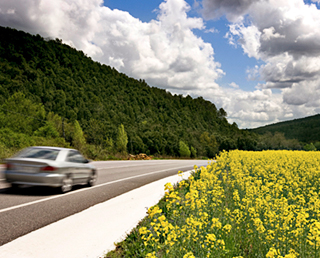Introduction
Legal basis
Considering the steady increase of energy consumption and the associated carbon dioxide emissions the European Commission decided to counter this trend. In particular the attention is on the transport sector, because the energy consumption there is still growing enormously. Furthermore the dependence on mineral oil for the transport sector, which is currently 98%, shall be reduced.
The first biofuels directive was published in 2003 and transferred into national law from the member states. By to the end of 2005 2% of fuel consumption should be covered with alternative resources, whereas this share should increase to 5.75% until the end of 2010. The Austrian law determined reaching the 5.75% goal already in January 2009.
In the year 2009 biofuels already covered 7% of the total fuel consumption in Austria – this is mainly because of the admixtures from biodiesel to fossil diesel fuel (max. 7 vol%) and from bioethanol to petrol (average 4.7 vol%). The progress in reaching the targets has to be reported annually to the European Commission. The relevant reports (Biofuels in the transport sector) are prepared by the Umweltbundesamt.
2009 two more directives were enacted – the transfer into national law should be finished by December 2010. The target is to cover 10% of the fuel requirements in 2020 from renewable resources (bio fuels and electric vehicles with clean power).
How “bio” are biofuels?
Biofuels are energy sources, produced from biomass and used as transport fuels. They are replacing fossil fuels and therefore contribute to the reduction greenhouse gas emissions the dependence of mineral oil. Furthermore they enable additional value for the local agricultural production.
How big the actual saving in greenhouse gas emissions is, is depending on the details for every sub step of the whole production chain. Within the preparation of a Life Cycle Analysis (LCA) all greenhouse gas emissions caused by use of energy, feedstock and auxiliaries, beginning with the cultivation up to the fuel combustion in the engine – that means from cradle to grave - are recorded. Fuels for tractors and fertilizers used for the cultivation of the feedstock are also counted as well as the conversion efficiency in the biofuel process and the effort of transport to the costumer.
Worldwide the European Union is leading the way in securing ecological and sustainable production of biofuels. The directive for renewable energy, published in 2009, intends minimum savings for greenhouse gas emissions compared to fossil fuels. At the moment this value is 35% and is increasing to 50% in 2017 and to 60% in 2018 for biofuels, which are produced in new facilities.
To calculate the reduction of greenhouse gas emissions standard values from the directive can be used. Alternatively one of the methods within this guideline can be applied. The BioGrace project ensures a quick and efficient calculation, with the aid of an excel tool using standard values, consistent results are guaranteed.

Biofuels, a renewable alternative
(c) BDI
Further information
Links
IEA Bioenergy Task 39 - Liquid Biofuels
Österreichischer Biomasseverband
Downloads:
Richtline zur Verwendung von Biokraftstoffen im Verkehrssektor
Einsatz von Biokraftstoffen und deren Einfluss auf die Treibhausgas-Emissionen in Österreich
Biokraftstoffe im Verkehrssektor 2011
Klimafreundlich mobil - Ideen für den Verkehr der Zukunft

